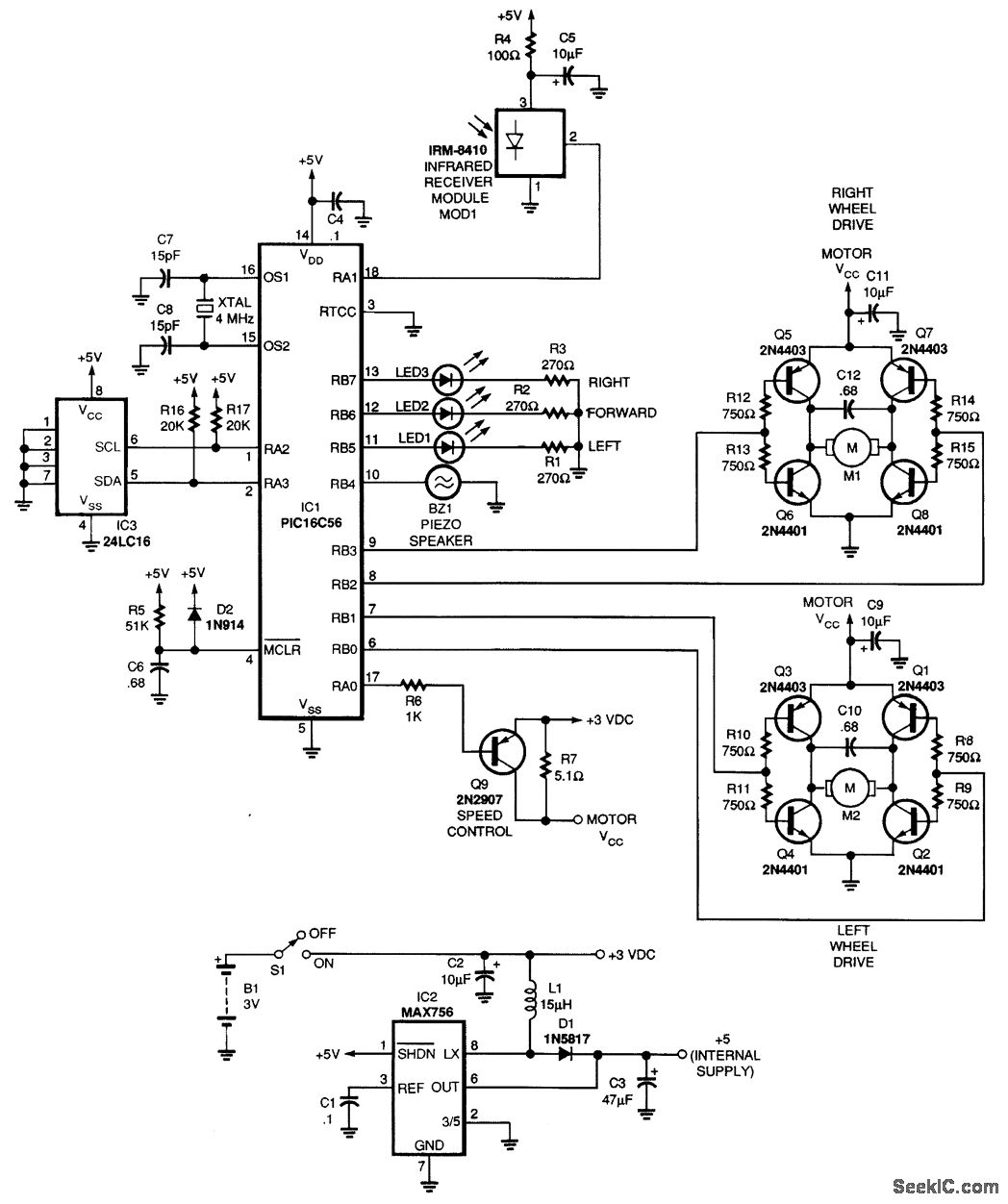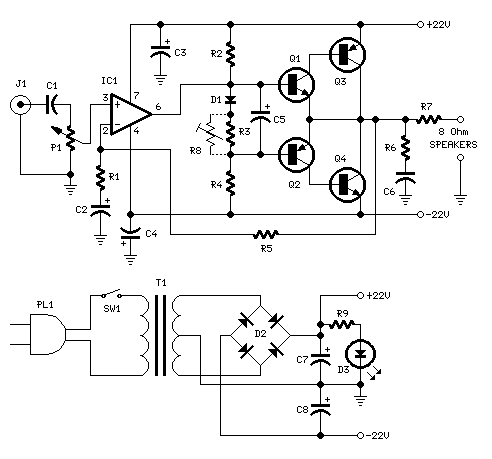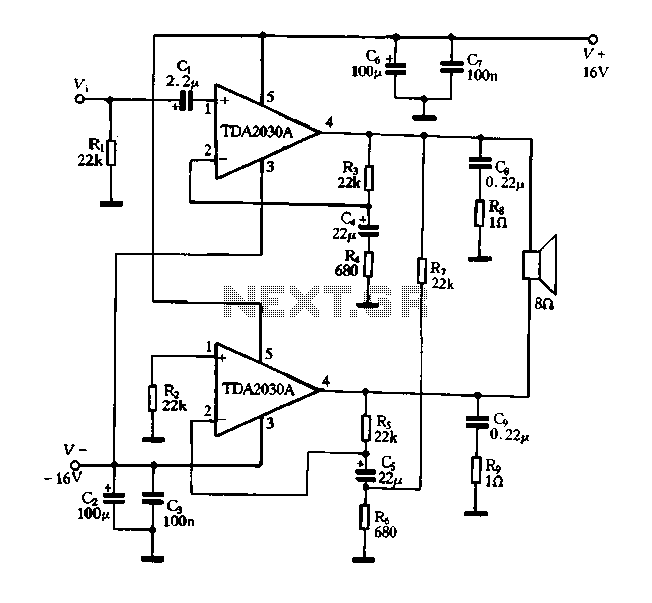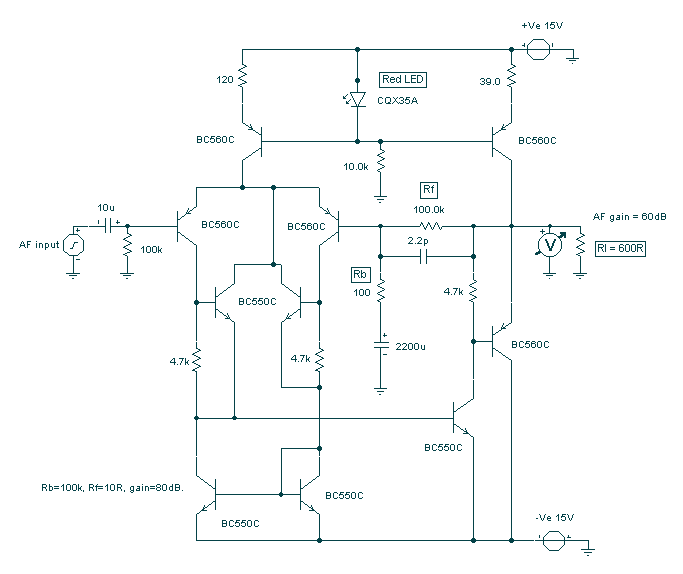
Two-meter 10 watt power amplifier

This 10-watt, 144-MHz power amplifier utilizes a TRW PT5757 transistor. The inductor LI consists of 4 turns of no. 20 enameled wire with a 3/32" inner diameter, while inductor L2 comprises 10 turns of no. 20 enameled wire with the same inner diameter. Additionally, transformer T1 is a 4:1 transmission-line transformer constructed from a 3" length of twisted pair no. 20 enameled wire.
The 10-watt power amplifier is designed to operate at a frequency of 144 MHz, making it suitable for various radio frequency (RF) applications, including amateur radio and communication systems. The TRW PT5757 transistor serves as the primary amplification component, chosen for its high efficiency and robust performance at the specified frequency.
Inductor LI, with its 4 turns of no. 20 enameled wire, is crucial for tuning the amplifier circuit and ensuring optimal performance. The choice of wire gauge and the number of turns are essential for achieving the desired inductance value, which plays a significant role in the amplifier's frequency response and overall efficiency.
Inductor L2, which consists of 10 turns of the same wire, likely serves a complementary function in the circuit, possibly related to feedback or output matching. The specific configuration of these inductors can significantly influence the gain and stability of the amplifier.
Transformer T1 is a 4:1 transmission-line transformer, which is instrumental in impedance matching between the amplifier and the load. By utilizing a twisted pair of no. 20 enameled wire, the transformer minimizes losses and enhances signal integrity. The 3" length of wire indicates a careful design choice that balances physical size with electrical performance, ensuring that the transformer operates effectively at the intended frequency.
Overall, this power amplifier circuit exemplifies a well-thought-out design that integrates key components to achieve a reliable and efficient amplification solution for RF applications. Proper attention to detail in the selection of inductors and transformers contributes to the amplifier's performance, making it suitable for demanding communication tasks.This 10-watt, 144-MHz power amplifier uses a TRW PT5757 transistor. LI is 4 turns of no. 20 enameled, 3/32" ID; L2 is 10 turns of no. 20 enameled, 3/32" ID Transformer T1 is a 4:1 transmission-line transformer made from a 3" length of twisted pair of no. 20 enameled wire.
The 10-watt power amplifier is designed to operate at a frequency of 144 MHz, making it suitable for various radio frequency (RF) applications, including amateur radio and communication systems. The TRW PT5757 transistor serves as the primary amplification component, chosen for its high efficiency and robust performance at the specified frequency.
Inductor LI, with its 4 turns of no. 20 enameled wire, is crucial for tuning the amplifier circuit and ensuring optimal performance. The choice of wire gauge and the number of turns are essential for achieving the desired inductance value, which plays a significant role in the amplifier's frequency response and overall efficiency.
Inductor L2, which consists of 10 turns of the same wire, likely serves a complementary function in the circuit, possibly related to feedback or output matching. The specific configuration of these inductors can significantly influence the gain and stability of the amplifier.
Transformer T1 is a 4:1 transmission-line transformer, which is instrumental in impedance matching between the amplifier and the load. By utilizing a twisted pair of no. 20 enameled wire, the transformer minimizes losses and enhances signal integrity. The 3" length of wire indicates a careful design choice that balances physical size with electrical performance, ensuring that the transformer operates effectively at the intended frequency.
Overall, this power amplifier circuit exemplifies a well-thought-out design that integrates key components to achieve a reliable and efficient amplification solution for RF applications. Proper attention to detail in the selection of inductors and transformers contributes to the amplifier's performance, making it suitable for demanding communication tasks.This 10-watt, 144-MHz power amplifier uses a TRW PT5757 transistor. LI is 4 turns of no. 20 enameled, 3/32" ID; L2 is 10 turns of no. 20 enameled, 3/32" ID Transformer T1 is a 4:1 transmission-line transformer made from a 3" length of twisted pair of no. 20 enameled wire.





